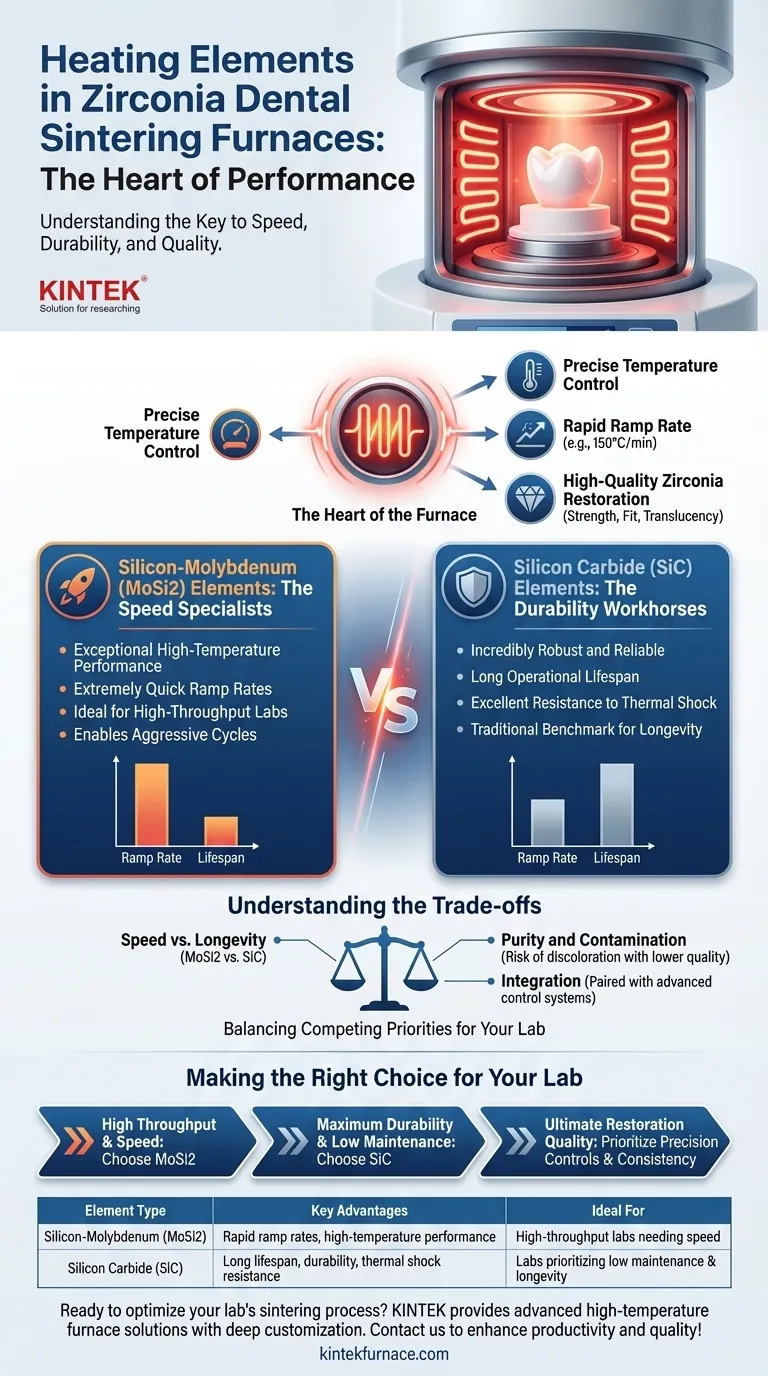The specific furnace you're asking about uses high-quality silicon-molybdenum alloy heating elements. This choice is not arbitrary; it is fundamental to the furnace's ability to achieve the rapid heating rates and high temperatures required for sintering modern zirconia materials effectively.
Understanding the type of heating element is the key to decoding a sintering furnace's performance. The choice between silicon-molybdenum and silicon carbide elements dictates the trade-offs between processing speed, operational lifespan, and the overall cost of ownership.
Why the Heating Element is the Heart of a Sintering Furnace
The quality of a final zirconia restoration—its strength, fit, and translucency—is directly determined by the precision of the sintering cycle. The heating element is the component most responsible for executing this cycle accurately.
The Goal: Perfect Temperature and Time
Sintering is a process of densification under heat. To achieve the desired material properties, the furnace must follow a precise temperature curve, holding specific temperatures for exact durations. The heating element's ability to respond quickly and maintain stable temperatures is paramount.
The Impact of Ramp Rate
The speed at which a furnace heats up, known as the ramp rate, is a critical performance metric. A rapid ramp rate, such as the 150°C per minute mentioned, allows labs to complete sintering cycles faster, increasing daily throughput. This capability is directly tied to the type of heating element used.
Comparing the Primary Heating Element Technologies
While other types exist, the market for dental sintering furnaces is dominated by two primary materials. Your decision-making process should be informed by their distinct characteristics.
Silicon-Molybdenum (MoSi2) Elements: The Speed Specialists
These are the elements used in the furnace in question. MoSi2 elements are known for their exceptional performance at very high temperatures and their ability to heat up extremely quickly. This is what enables the aggressive ramp rates favored in high-production labs.
Silicon Carbide (SiC) Elements: The Durability Workhorses
Often cited as a benchmark for reliability, SiC elements are incredibly robust and have a long operational lifespan. While many modern SiC elements have excellent ramp rates, they are traditionally valued more for their longevity and resistance to thermal shock over thousands of cycles.
Understanding the Trade-offs
Choosing a furnace is about balancing competing priorities. The heating element is at the center of these trade-offs.
Speed vs. Longevity
The primary trade-off is often between cycle speed and element lifespan. MoSi2 elements facilitate the fastest cycles but can be more susceptible to aging and require more careful handling. SiC elements typically offer a longer service life, potentially reducing long-term maintenance costs.
Purity and Contamination
High-quality elements of either type are designed to be pure. Lower-quality elements, regardless of material, can release contaminants at high temperatures, which may lead to discoloration of the zirconia restorations. Element quality is just as important as element type.
Integration with Other Features
A superior heating element is only effective when paired with a sophisticated control system. Features like a touch screen interface and programmable sintering curves allow the user to leverage the element's power with precision, tailoring cycles to specific zirconia brands and restoration types.
Making the Right Choice for Your Lab
Your ideal furnace depends entirely on the specific goals and workflow of your dental lab.
- If your primary focus is high throughput and rapid turnaround: A furnace with silicon-molybdenum (MoSi2) elements is optimized for speed and efficiency.
- If your primary focus is maximum durability and lower maintenance over many years: A furnace with high-quality silicon carbide (SiC) elements is a proven, robust choice.
- If your primary focus is ultimate restoration quality: Look beyond the element type alone and prioritize furnaces with exceptionally precise temperature controllers and automated programs that ensure consistency.
Ultimately, a deep understanding of these core components empowers you to select a tool that aligns perfectly with your lab's operational needs.
Summary Table:
| Element Type | Key Advantages | Ideal For |
|---|---|---|
| Silicon-Molybdenum (MoSi2) | Rapid ramp rates, high-temperature performance | High-throughput labs needing speed |
| Silicon Carbide (SiC) | Long lifespan, durability, thermal shock resistance | Labs prioritizing low maintenance and longevity |
Ready to optimize your dental lab's sintering process? Leveraging exceptional R&D and in-house manufacturing, KINTEK provides diverse laboratories with advanced high-temperature furnace solutions. Our product line, including Muffle, Tube, Rotary Furnaces, Vacuum & Atmosphere Furnaces, and CVD/PECVD Systems, is complemented by our strong deep customization capability to precisely meet unique experimental requirements. Contact us today to discuss how our furnaces can enhance your productivity and restoration quality!
Visual Guide

Related Products
- Chairside Dental Porcelain Zirconia Sintering Furnace with Transformer for Ceramic Restorations
- Dental Porcelain Zirconia Sintering Ceramic Vacuum Press Furnace
- Laboratory Muffle Oven Furnace with Bottom Lifting
- 1800℃ High Temperature Muffle Oven Furnace for Laboratory
- High Temperature Muffle Oven Furnace for Laboratory Debinding and Pre Sintering
People Also Ask
- What are some key features of dental sintering and porcelain furnaces? Optimize Your Dental Lab's Workflow
- What role does temperature range and accuracy play in dental furnace performance? Ensure Precision for Superior Dental Restorations
- What are the recommended maintenance practices for dental furnaces? Ensure Precision and Longevity for Your Lab
- What is the importance of dental furnaces in dentistry? Ensure Strong, Precise Dental Restorations
- What safety measures should be followed when using a sintering furnace in dental labs? Ensure Safe, High-Quality Dental Restorations



















